Plant Profiles dive deep on one plant variety each month. They are meant to provide you with enough information to make good growing decisions. A desire to grow gorgeous flowers is one thing. However, discerning if a particular plant is right for you and your climate is a whole other ballgame.
My intention here is to give you as much practical information to make these decisions. However, I’m going one step further and taking you completely behind the scenes to share exactly what has worked for us as well. For this reason, Plant Profiles are broken up into what I’m calling the “Nuts and Bolts (N&B)” and “Behind the Scenes (BTS).”
If you haven’t already, please be sure to read the FFY Introduction to learn more about how Plant Profiles are organized.
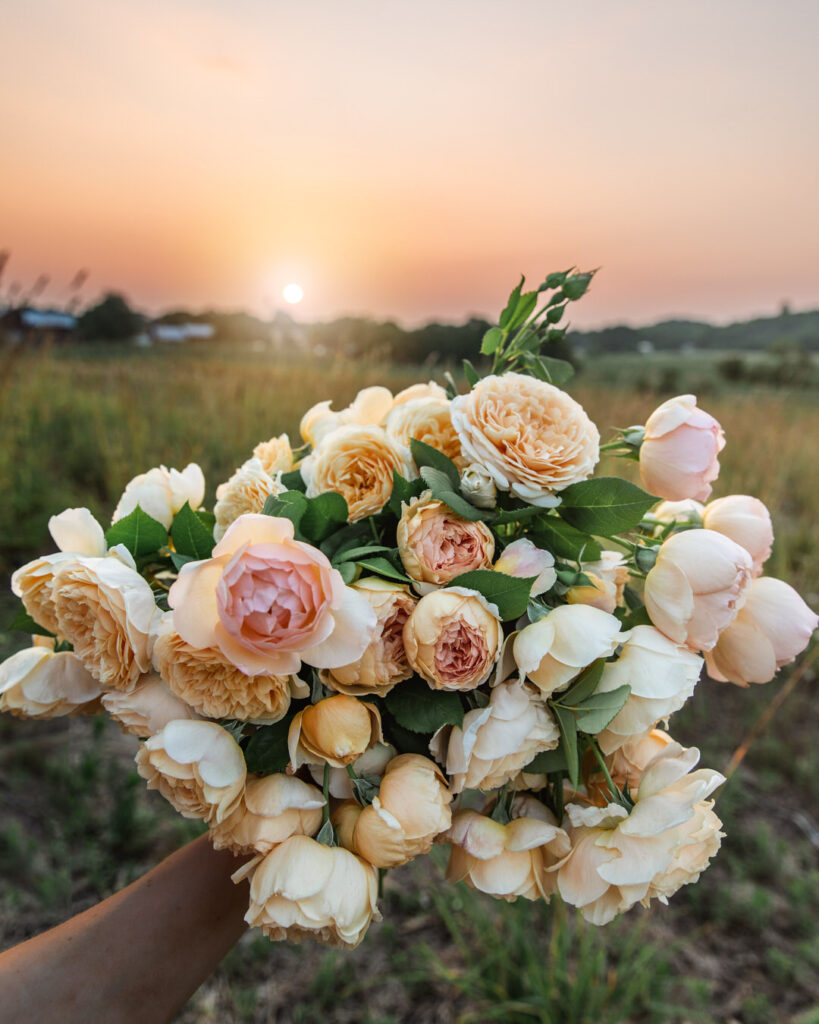
Primary Sources
The primary sources for the N&B portion come from:
- Alvarez, F. Growing Wonder: A Flower Farmer’s Guide to Roses. BLOOM Imprint.
- David Austin Roses
- Heirloom Roses
- Let’s Grow Girls Podcast
- Menagerie Farm
Zone Considerations
- David Austin Roses sells roses rated to different zones
- Heirloom Roses sells roses rated to different zone
- Menagerie Farm is in Zone 7b, but sell roses rated to different zones
- My farm, Petal Back Farm, is located in Zone 4b Wisconsin
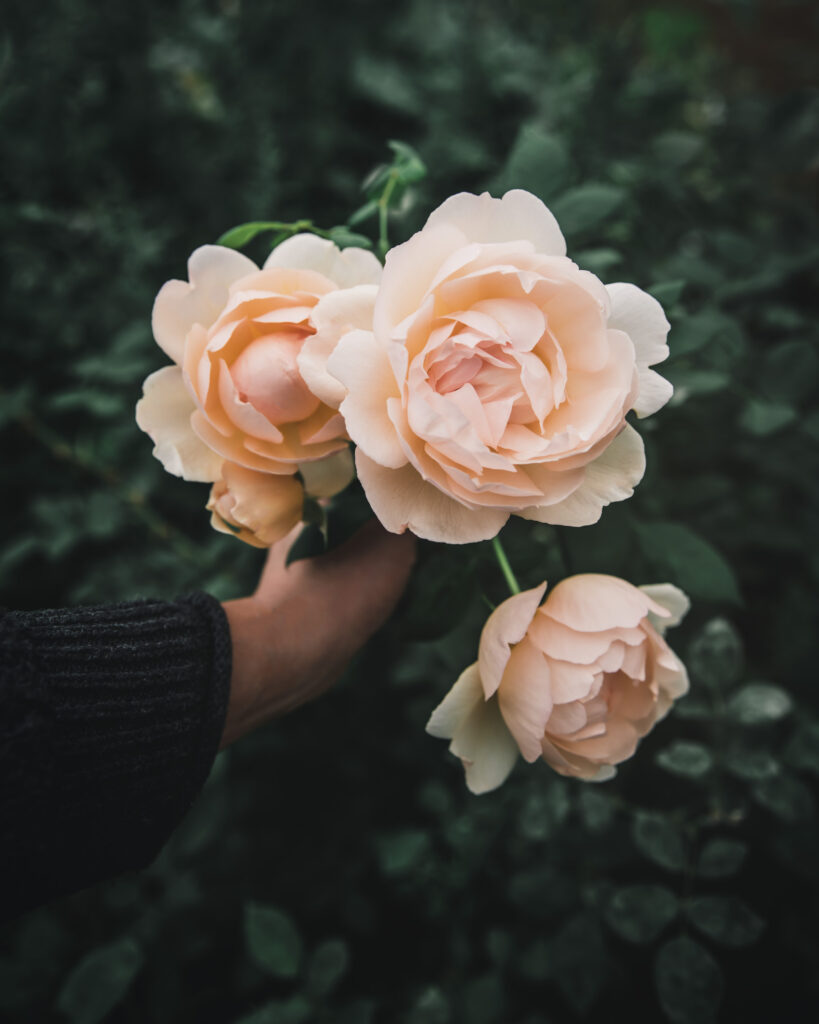
General Information: N&B
- Genus Name: Rosa
- Common Name: Rose (Species Rose, Old Garden/Heirloom Rose, Modern Rose)
- Life Cycle: Perennial
- Spacing: At least 2 feet between plants
- Height: depends on variety
Growing roses can become a bit of an obsession. For design work, they are a breathtaking sight with intoxicating fragrance. But with so many varieties out there, what makes a rose a great cut flower? Are they difficult to grow? Are they worth growing for the flower farmer? I used to think no, but through my research and unexpected experience, my tune has completely changed on this.
There are a few key factors to success with roses as a cut flower:
- Right variety
- Appropriate zone
- Disease resistance
- Right location
- Full sun (6–8 hours)
- Average soil with good drainage (and amended based on soil tests)
- Minimal wind
- Sufficient rainfall or supplementation (especially for new plants or in summer, 1 inch per week)
- Pruning for optimal health
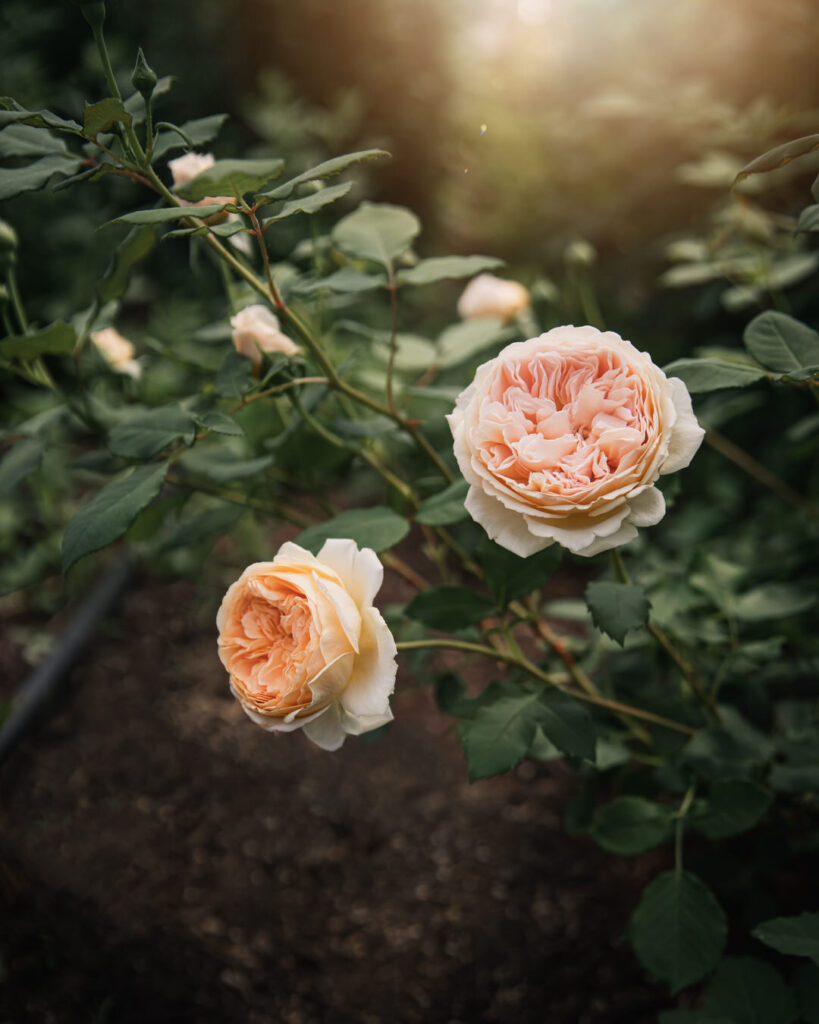
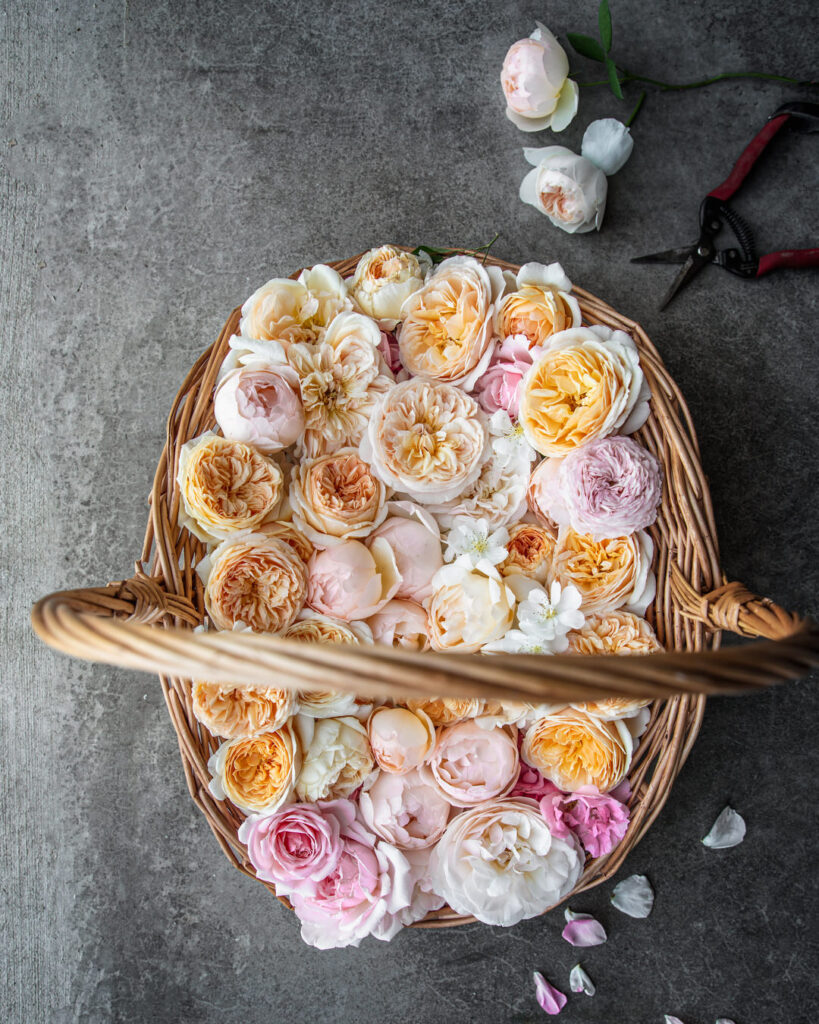
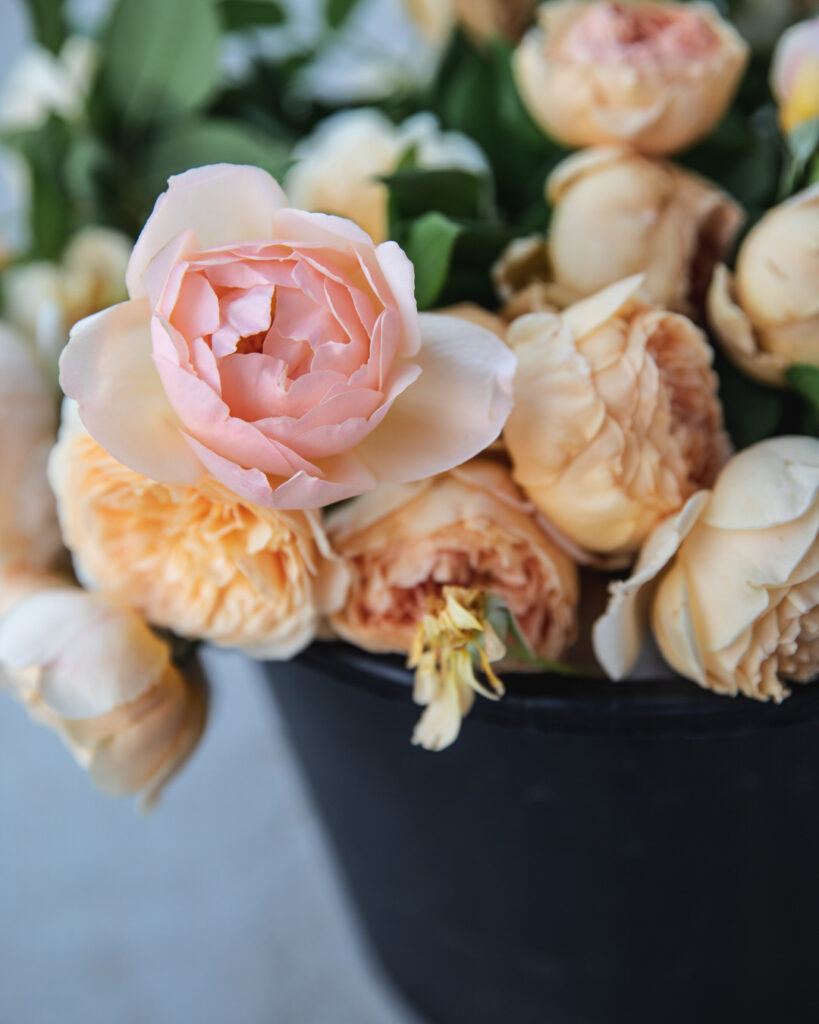
General Information: BTS
While I am a newer rose grower, I get a lot of questions about growing roses (especially in our Zone 4), so I decided to dedicate a plant profile to share what I’ve learned so far. When we started the farm, I did not think that garden roses would be something that we would grow for cuts. For whatever reason, I thought they were impractical, finicky, and perhaps not worth the effort.
In fact, the first roses I grew were for the landscape. I got them for free in an exchange for a blog post. Then, when we started the AirBnB, there was the most-charming fence line around the property. I thought a fence line of roses would be wonderful for guests to enjoy. Even then, the thought of growing roses for the farm had not even crossed my mind. However, we learned that the septic needed to be expanded for the amount of bathrooms in the home, so the fence would have to be removed to accommodate this.
I was not sure what I was going to do with the roses. While some were definitely hardy landscape roses, others were fancy David Austin garden roses that I maybe, sorta impulse purchased. When I took the Floret Online Course, I recalled a fellow student wrote how she grew roses rated to Zone 6 in her high tunnel in Zone 4. I had just enough space that opened up in our newly-constructed high tunnel, so the fancier garden roses went in the tunnel. Much to my surprise, it has worked like a charm, and I’ve begun to change my tune on roses for the cut flower farm. In fact, you could say I’ve become quite obsessed.
While I have not put roses in market bouquets, I have used them in mason jar arrangements, and more often for special arrangements and events (Crown Princess Margareta came in particularly timely for the flowers we did for Indy Car Race at Road America). Despite not advertising roses other than showing pictures on social media, we’ve also had requests for dried rose petals for skincare. Bonus, I actually love plants that are repeat bloomers that require deadheading, because they are great opportunities for images for social, marketing, or farm products/swag.
All that to say that my initial reaction is that roses can be more profitable for the cut-flower farm than I had originally assumed.
What I love most about roses as a cut flower:
- Easy to grow (despite reputation of being difficult to grow, they are quite tough, just need to know a few key tips)
- Perennial (purchase once, plant once, plants last for many years)
- Showstopping blooms
- Repeat blooms (As David Austin notes, roses flower more abundantly than almost all other garden plants)
- Premium bloom (premium price tag)
- Great for design
- Multiple plants through propagation (if allowed)
- Many have wonderful fragrance
- Popular with florists and retail customers
- Nostalgic flower
- Premium flower for weddings, events
But every rose has its thorn, right? (Like quite literally). Potential shortcomings:
- Higher upfront investment compared to annuals
- Slightly more maintenance than other perennials, like peonies
- Some varieties are, in fact, super thorny
- Perhaps a bit more fragile than other flower varieties, but I’m learning they are tougher than we give them credit for
- Not as long of storage as flowers like peonies and tulips
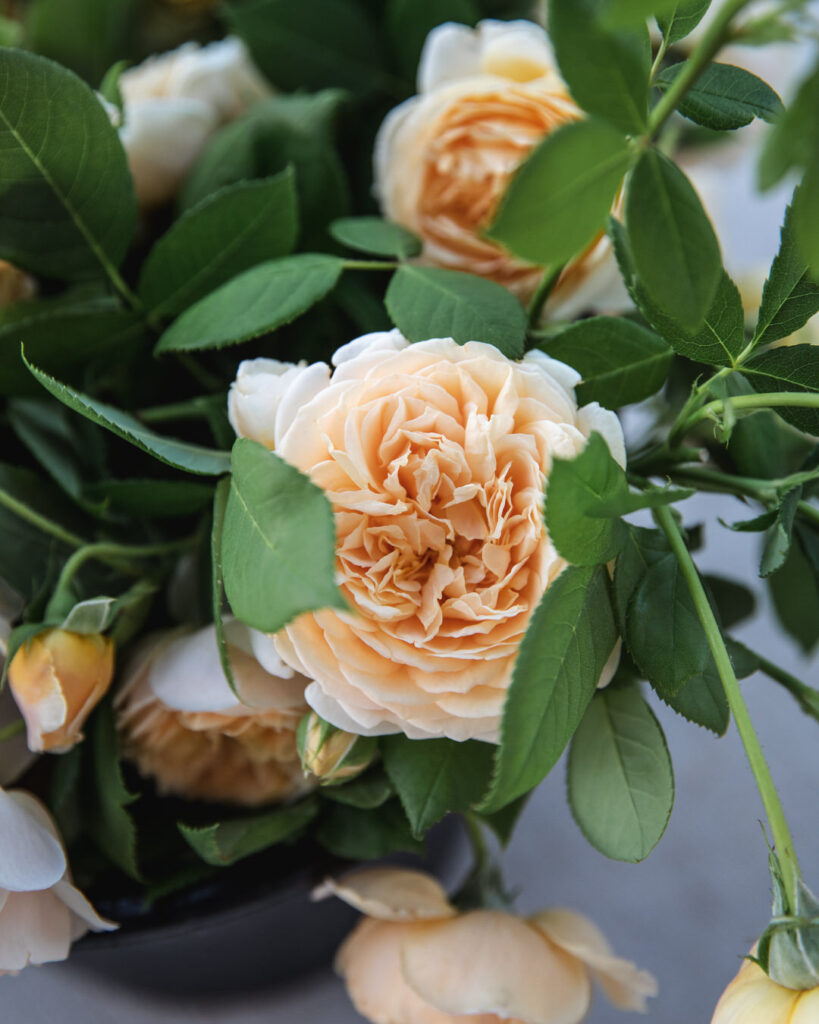
Categories & Classifications: N&B
Roses are a diverse species. They can be classified under three main categories (Species roses, Old Garden/Heirloom roses, and Modern roses). Under these three categories, there are at least 20 classifications (Heirloom roses).
Species roses: Wild and native roses, that form thickets and rosehips, typically singe flowers with 5 petals.
Old Garden/Heirloom roses: robust shrubs that predate 1867, typically once blooming. They include the following classes:
- Alba
- Centifolias
- Damask
- Gallicas
- Tea
- Moss
Modern roses: typically repeat bloomers with large, beautiful flowers. They sometimes lack the fragrance of old garden roses, though modern breeders are breeding for scent and disease resistance. Roses grown for cut flowers typically fall under this category. They include the following classifications:
- Climbing
- Large-flowered climbers
- Rambler-type climbers
- Climbing sports (taller varieties of shrubs and most roses for cut flowers fall under this category)
- Hybrid Teas (single stemmed upright canes, 3-6 ft tall)
- Floribundas (large clusters on a compact plant; good for containers)
- Grandifloras (large stems of single or clusters, hardy, up to 7 ft tall)
- Miniatures (range from 3 in to 2 ft; flowers, stems and leaves are all petite)
- Shrubs (hardy, easy care plant that doesn’t fit into another category)
- English (aka David Austin roses) while not technically their own class (they belong to the shrub class), most growers consider them a class of their own. They were introduced in 1969 by English-Rose hybridizer David Austin, who bred varieties that combined elements of old roses and modern roses (cupped-shaped blooms, strong fragrance, repeat flowering).
(Sources: Alvarez and Heirloom Roses)
If you really want to get scientific/geeky on rose types, parts, aspects, and terms, check out Heirloom Rose’s Glossary.
Categories & Classifications: BTS
Although we have some rose varieties for landscape and medicinal purposes, our rose varieties grown for cut flowers are modern roses.
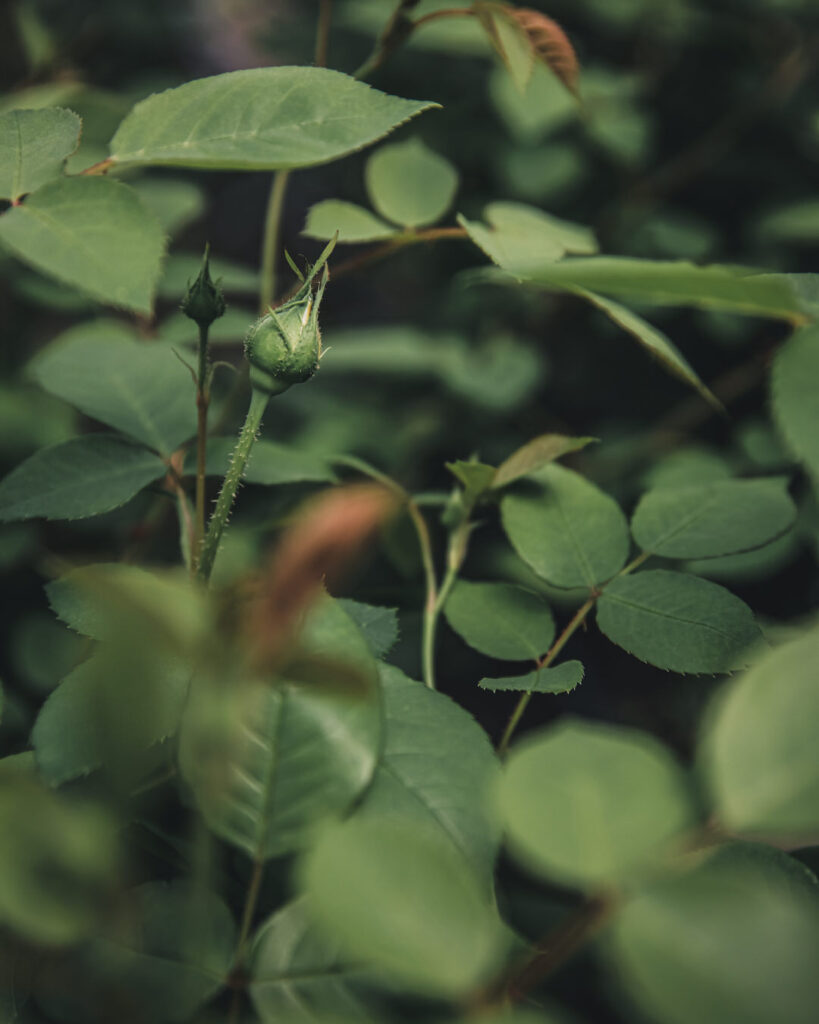
Propagation: N&B
Plants are typically purchased as bareroot plants or potted plants in containers. They are either own-root roses or grafted roses.
Bare Root Roses versus Potted/Container Roses
Bare root roses are roses in their dormant state, delivered without foliage or soil. They will put on some growth and produce some flowers in their first summer. They can be ordered all year round for delivery between January and May, depending on your location (David Austin). Bare root roses should be planted in their dormant season, before warmer weather arrives. The exact timing depends on location, but both Alvarez and David Austin recommend January through May, based on your growing zone:
- Zones 9–13: late January to late-February
- Zone 8: mid- to late-February
- Zone 7: early- to mid-March
- Zone 6: mid- to late-March
- Zones 3–5: early- to mid-April
- (Source: Alvarez)
Bare root roses are typically less expensive than potted roses and more environmentally-friendly when it comes to shipping. You can usually find a wide selection of varieties, as well as more rare varieties. According to Alvarez, bare root roses root faster and get more established in their locations faster.
Potted plants are grown in a container with growing media. Typically, 3- or 5-gallon containers are available for pickup at local nurseries, garden centers, or large retailers. Mail-order and online nurseries offer one-gallon (or smaller) plants (sometimes called “band pot” or “banded roses”). Alvarez explains that as a cut-flower farmer, she prefers to start her roses from bare root plants or 3- to 5-gallon potted roses. She notes that band pots require more work, attention, and time to produce a full-sized rose with cuttable stems (saving banded pots for varieties she’s willing to grow with patience).
However, Heirloom Roses notes that their industry gallon-sized roses will put on substantial growth in the first year and quickly outperform their grafted counterparts. According to them, “gallon-sized roses are a great option for gardeners who live in areas with a shorter growing season, or those that desire a more mature plant. Each of our roses are hand propagated, grown on their own roots, hardy, healthy, and virus-free. You can expect blooms and up to 4 feet of growth the first year.”
If ordering directly from David Austin, their potted roses arrive planted in a 2-quart plastic pot with soil and foliage: “Depending on the time of year, they may arrive in bloom, or will bloom shortly after planting. They can be planted outside of bare root season and can be enjoyed almost immediately.”
Own-Root Roses versus Grafted Roses
According to Alvarez, “Grafted roses, also known as budded roses, are roses that have a top stock variety and a bottom stock variety. The shoots, or the canes, that grow above the ground are a different variety than the roots that grow below ground. The top stock is ‘grafted’ or attached to the bottom stock so they grow together as one plant.” The reason for this is to help the rose have improved hardiness, disease resistance, and resistance to adverse weather conditions.
On the other hand, own-root roses are grown from a single-variety cutting that develops its own root system. So, unlike a grafted rose, all parts of the plant are of the same variety.
Heirloom Roses (which only sells own-root roses) notes that own-root roses have advantages to grated roses:
- Own-root roses are hardier than grafted roses because their crown has not been weakened. The bud union of a grafted rose is vulnerable to cold and can be easily damaged during a hard winter.
- Own-root roses come back true to variety if frozen to the ground, because they have their own root system. Winter kill is less likely.
- Own-root roses are shapelier because they send up shoots from their own roots. This creates a fuller plant over time, which adds to increased vigor, bloom, and life expectancy.
- Own-root roses have no rootstock suckers, meaning more energy is sent to the main plant.
- (Source: Heirloom Roses)
They also note that while grafted roses my have more vigor, by the time that an own-root rose is 3 years old, it will be identical in size to a grafted rose of the same age (if not sooner).
However, Alvarez notes that no one type is better the other and that both will grow beautiful, hardy roses. That said, she does suggest that Zones 3–5, while they can grow grafted roses, they may need more winter protection and to try a few in your garden to see how they fare.
Suckers explained. Suckers are rose canes that grow from below the graft of a grafted rose plant. The reason they are so obnoxious is because they are of the rootstock (meaning they will not flower the color and form of the top stock). Alvarez explains that the best way to treat a sucker is to grab it and pull it down and off completely where it connects (like a bandaid).
Bare Root Grade Selection
Roses in the United States are graded in order to standardize the quality of roses sold by all retailers. According to Alvarez, “A Grade 1 grafted rose needs three canes branched no higher than three inches above the bud graft, measuring at least 5/16-inch in diameter. A Grade 1.5 rose has at least two strong canes, while a Grade 2 needs one 5/16-inch cane, and at least one at 1/4-inch.” She further explains that own-root roses and grafted roses can be different in size but the same grade because the grading is different (same with imported roses). Ultimately though, Grade 1 is the top grade and the most expensive, followed by 1.5 and 2.
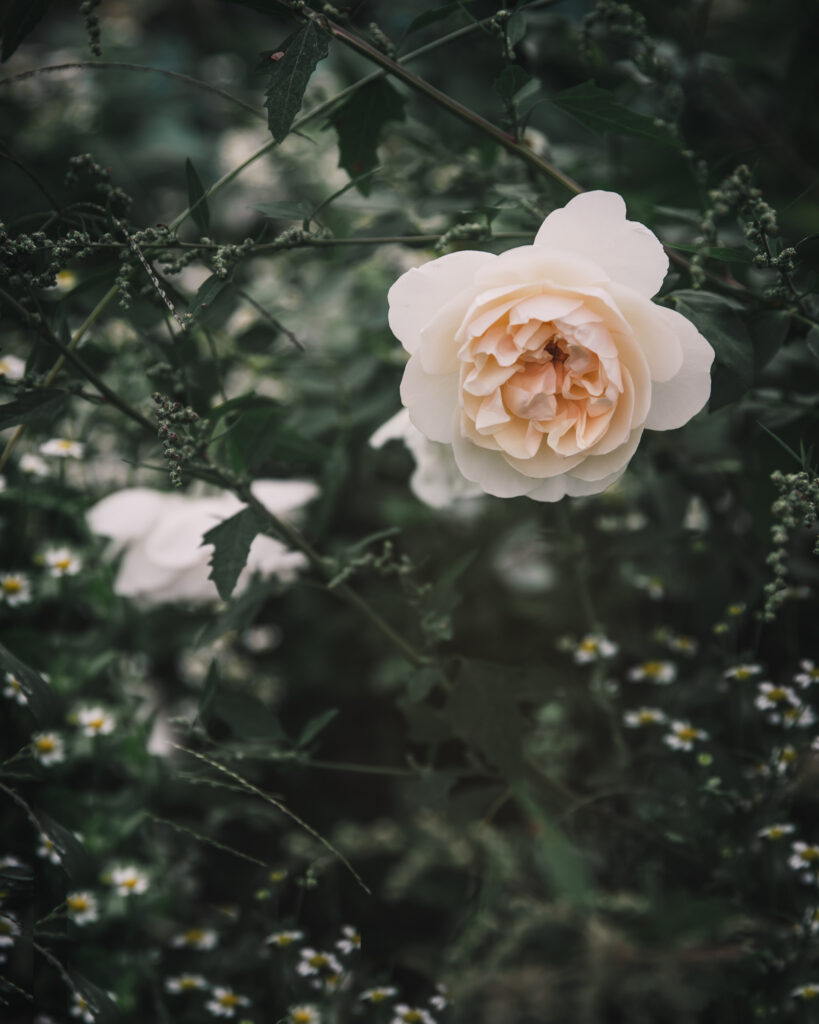
Propagation: BTS
The first roses I planted were all own-root roses. I was already so convinced that roses would be such a PITA that I didn’t want to introduce an extra concern with grafted roses. That said, now that I’ve been completely bitten (and smitten) by the rose bug, I planted some grafted roses this season. So, we’ll be on the look-out for suckers and give extra protection in winter (we are also growing these in a high tunnel).
I’ve grown both potted roses and bare root roses. My own-root potted roses from Heirloom Roses have done beautifully and did have vigorous growth. Similarly, my bare root roses I planted from Menagerie are doing well too. Thus far, I cannot say I prefer one over the other, but we’ll see how the grafted bare root roses fare this winter (I do also choose Grade 1).
Environmental Factors: N&B
If you’ve dug into the rose world, you’ve likely heard the mantra, “Right rose, right location” and Alvarez adds, “right time.” If you’re not familiar with this yet, remember this 3R mantra for successful rose growing. Choose a sunny location that has minimal wind with well-drained soil and a pH of 6.0–7.0. Roses truly are sun lovers (6–8 hours), but there are varieties that tolerate shade (and most sellers give you the option to filter for shade-tolerant varieties when purchasing).
It’s also important to know your hardiness zone, so that you can choose a variety suitable to your zone.
An important note about Hardiness Zones that most people miss: Hardiness Zones (or Planting Zones), though useful, are only based on the average annual minimum winter temperature. The U.S., for example, is divided into into eleven 10-degree zones by minimum average annual temperatures. Each zone is also divided into “a” and “b” segments. These represent five degrees of temperature difference.
In plain English, your zone number simply refers to how cold your winters get. The lower the number is, the lower the temperatures in that zone. For example, where I live in Mindoro, WI, we are Zone 4b, meaning our average minimum temperatures are -25°F to -20°F (yup, it can get freakin’ cold). When a plant is rated for a particular zone, it’s referring to how well that plant will survive cold temperatures, and this is particularly useful when planting perennials like roses.
Growers in colder zones can grow roses in tunnels or greenhouses that mimic conditions one to two zones warmer than their location’s growing zones (Alvarez).
Environmental Factors: BTS
While we grow some landscape roses, the roses I grow for cuts are primarily grown in our high tunnel. Because they bloom throughout the season, I think they are worth the precious real estate. So much so that I continue to add to it without plans to quit. I think the added protection from the cold and wind is absolutely worth it!
So far, I’ve only grown roses rated as high as Zone 5 (with success), but I added a few Zone 6 roses this spring (we’ll see how they do through the winter). Even though ours are grown in a high tunnel, I’ve always been known to zone jump. I believe many of the zone recommendations are conservative, but ya know, try at your own risk.
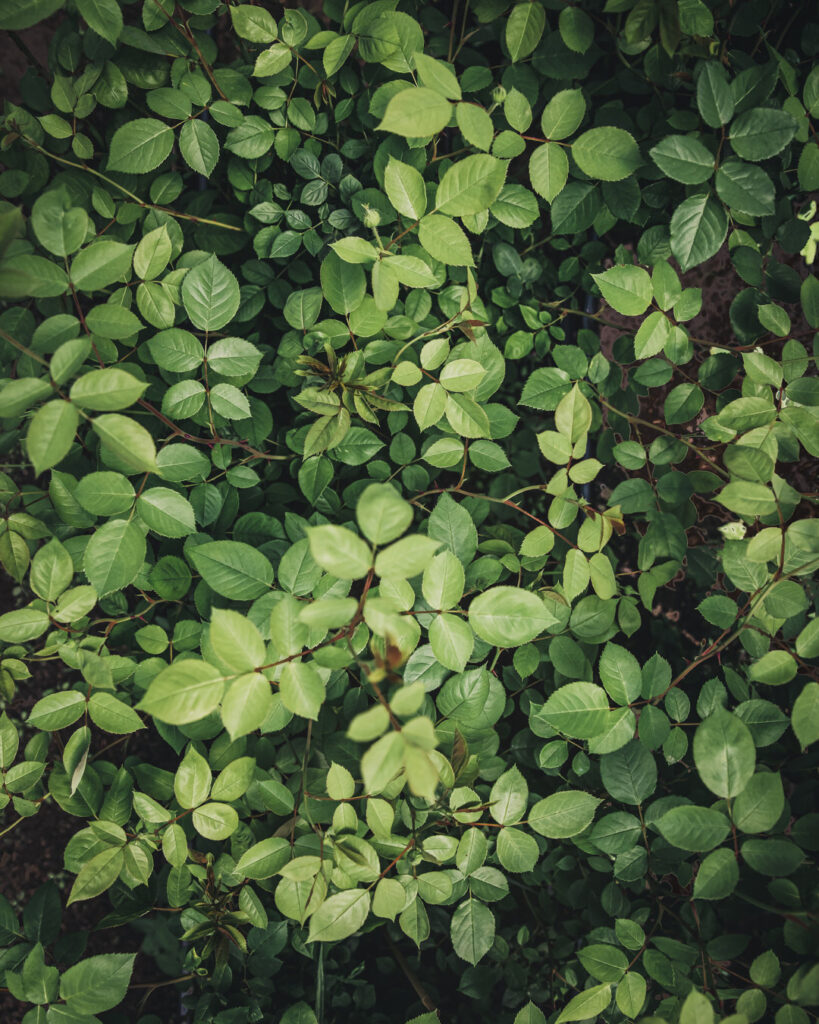
Planting: N&B
As noted earlier, bare root roses should be planted in their dormant season (suggestions above under “Bare Root Roses versus Potted/Container Roses. Potted roses should be planted after last frost.
Prior to planting, most sources will recommend getting a soil test and amending the soil according to the results. While Alvarez also recommends this, she also notes that the most important thing is to get your rose plant in the ground! You can always add compost or amendments later.
Plant spacing varies by variety, goals, and preference, but most sources recommend at least 2–4 feet between plants. The good news is that if you plant roses and decide it’s not working for you, you can dig them up and move them during their dormant season. Alvarez comments that rearranging roses is as easy as rearranging furniture.
If planting bare root roses, rehydrate roots in a bucket of water for a minimum of 2 hours prior to planting.
Most sources will recommend digging a planting hole two-feet deep by two-feet wide for planting roses, but Alvarez says to simply dig the planting hole big enough to fit the pot your rose came in or to the depth of the bare root rose’s roots. Although a search on the internet will recommend throwing all sorts of things into the planting hole, most sellers advise to never add granular fertilizer into the planting hole of first-year plants to avoid burning the roots and potentially killing the rose.
Alvarez recommends high-quality, well-aged compost at a ratio of 1:3 compost and 2:3 native soil mixed in the top 3–6 inches. While Heirloom Roses also advises against granular fertilizer, they do suggest adding peat moss, their own Aged Cow Manure and bone meal per package instructions. Similarly, David Austin recommends a mixing one spade-full of well-aged manure in the whole and two spade-fulls with the native soil to be placed back into the hole. Additionally, they suggesting sprinkling the roots with Mycorrhizal Fungi when planting.
For grafted roses, Alvarez recommends planting the bud union 2-3 inches below the ground in colder climates. In warmer climates, she recommends planting the bud union 1-2 inches above the ground. For own root roses, plant to the base of the canes.
Alvarez recommends adding a layer of compost as mulch or a layer of mulch and compost.
Alvarez recommends watering new roses daily for 1–2 weeks and then one inch of water per week thereafter. She says to water bare root roses overhead until foliage starts to emerge. Water at the base thereafter.
Planting: BTS
We plant as recommended above. We amend our soil each season based on a soil test (more blow under Nutrition). When planting, we mix in compost, peat moss (if we have it), and Mycorrhizal Fungi (when I think of it, because I almost always have it on hand). I also lay a thick layer of compost as mulch over the bed, watering daily for 1–2 weeks.
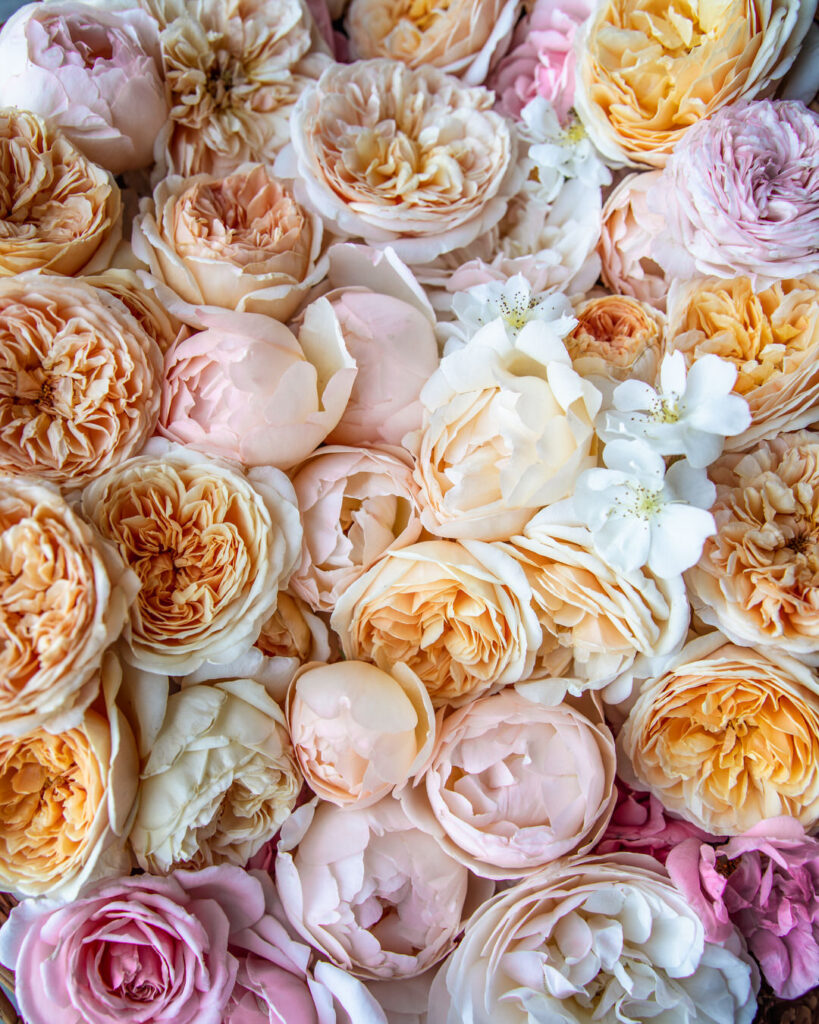
Nutrition: N&B
Most growers recommend initially amending soil based on a test. Most sources state that roses do not need fertilizer, but that they will perform better if fertilizer is utilized. That said, most recommend not using granular fertilizer the first year (and some warranties will not apply if you do choose to use granular fertilizers in the first year). During the following seasons, most recommend using granular fertilizers based on soil tests or a complete rose fertilizer.
For example, Heirloom Roses recommends only using liquid fertilizer the first year every 4-6 weeks during the blooming season (and that the use of granular fertilizer during the first growing season will void their one-year warranty). They suggest their Founder’s Fish Fertilizer. During the following growing seasons, they recommend using a liquid fertilizer every 4-6 weeks or granular fertilizer every 2-3 weeks throughout the growing season. Late in the fall, they suggest applying fertilizers with little or no nitrogen, such as bone meal or rock phosphate, to help promote root growth and next year’s blooms.
David Austin recommends feeding roses twice per season: The first, at the beginning of the growing season. The second, after the first bloom cycle has finished, promoting stronger repeat flowering. They recommend their own specially-formulated David Austin Rose Food.
Alvarez recommends not apply any rose fertilizer until you see your first set of leaves push out. After the first full sets of leaves appear, she suggests feeding the plant with a balanced rose fertilizer once every 6-8 weeks. However, she also notes that feeding based on a soil test is good, because if your soil is already high in nutrients, you may not even need to apply a fertilizer. Some of her favorite fertilizers are E.B. Stone Rose Fertilizer Granular and Dr. Earth Rose & Flower Fertilizer Granular. She also notes that a foliar fertilizer spray every 3 weeks is nice in addition to your granular fertilizer application. She recommends E.B. Stone Organics Liquid Plant Food or Dr. Earth Total Advantage Rose & Flower Concentrate Liquid Fertilizer.
All sources recommend stop fertilizing 6-8 weeks before your first typical frost date.
Nutrition: BTS
If you’ve been around FFY, you know that we fertilized our soil organically based on a soil test. If you’re new, you can access this PDF that breaks down exactly what we do here. Our soil is so whacky from conventional farming (off the charts P and K) that I don’t get too crazy with adding nutrients. What I do add, I typically calculate myself based on my most-recent test (I show you how in the PDF). That said, while I cannot remember where, I have read that roses like alfalfa. Since alfalfa is higher in N compared to PK (which we need), I will sprinkle some around the rose bushes. If they start to look tired, I may try the Dr. Earth brand as it’s easy to find (and I have some on hand for my lemon tree which I like . . . it’s the “Bud and Bloom” . . . it’s very similar).

Irrigation: N&B
Roses love water but how much water is highly dependent on your location, soil type, and the amount of rainfall you receive. Trying to research this one can make your head spin, but I find this table from David Austin a good resource:
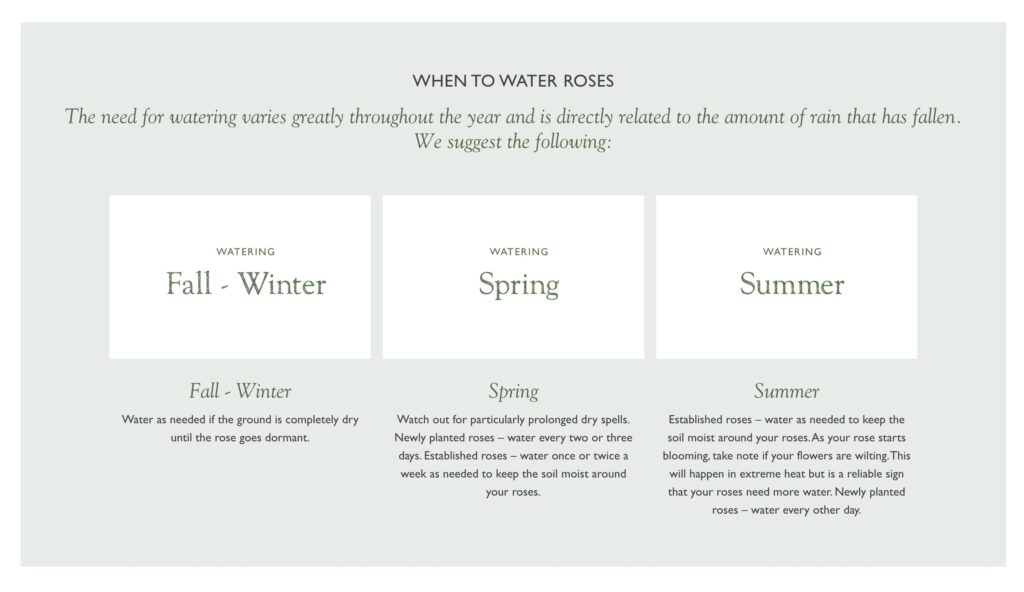
Ultimately, how much water will depend on your soil type, but other than watering in newly-planted bare root roses, plants should be watered at the base to avoid disease.
Irrigation: BTS
In the high tunnel, during really warm spells (feels like all summer), we water almost daily via drip line. The tunnel doesn’t get any rainfall and our soil is extremely sandy (our first soil test came back 80% sand, though we have added massive amounts of organic matter, compost, and black dirt to help with this). During milder times, we’ll water 1–2 times per week. We’ll stop watering once plants go dormant in the winter and will only start to water sparingly starting in late Feb or early March.
Mulch: N&B
Most sources recommend mulching roses to cool soil temperatures, conserve moisture, and suppress weeds. While you can do this at any time of year, early spring is usually best. David Austin recommends small bark chippings. Due to the high number of mulch options, Heirloom Roses and Alvarez recommend finding a local supplier to provide best options for your region. That said, Heirloom Roses does offer Mint Mulch (on a side note, I could swear they used to have a video about mulching with cardboard followed by compost, but I cannot find it, I can only find this one which is similar bit a little bit different). For landscape roses, Alvarez recommends a two- to three-inch layer of compost, followed by a two- to three-inch layer of mulch. For a commercial rose field, she recommends 2 to 3 applications of compost throughout the season (she notes that they aggressively hand-cultivate weeds and that the mulch can make it more difficult on a commercial scale because it ends up in the pathways).
Mulch: BTS
I love mulch! Even if I don’t always get around to doing it 🙂 Almost everything on our farm gets a layer of compost “mulch” and what I mean by that is a layer of compost on top of the bed that does not get mixed into the soil. I gardened like this for years, so I just continue to do it for most things I grow. The landscape roses get cardboard followed by a thick layer of compost. The high tunnel roses get a thick layer of compost. I may experiment with cardboard or paper underneath because we still have a lot of weed pressure and I fall behind on hand cultivation.
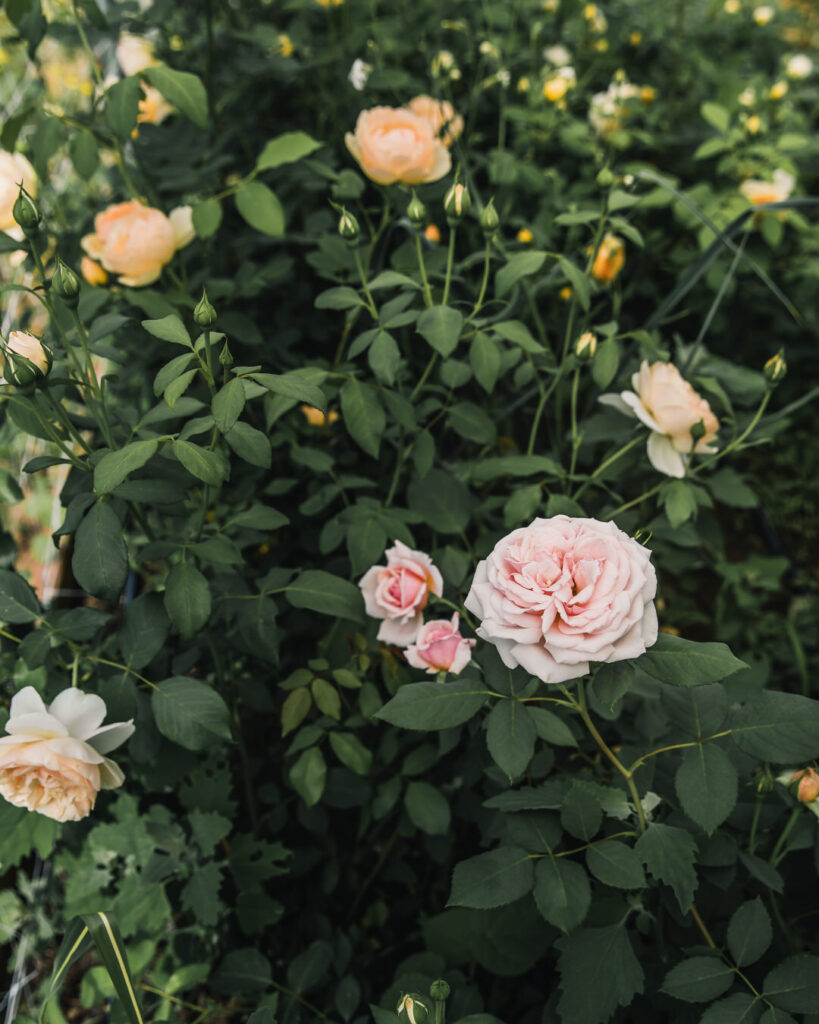
Pests & Disease: N&B
Let’s Grow Girls podcast has two interviews with folks from David Austin Roses and what I love most is that both guests emphasize that pests and diseases are just a part of gardening and are not that big of a deal. They talk about pests attracting beneficial bugs and that it’s all part of the larger ecosystem. Only in rare occasions do pests and disease get so out of control that a rose is totally lost. Roses are tough, afterall. They do not spray but they do introduce beneficial insects. What a breath of fresh air, right? They both suggest selecting disease-resistant varieties, planting in a sunny location, and providing enough water and air circulation.
When it comes to pests and diseases, the first step is to monitor your roses and know the most-common pests and diseases. Common pests include thrips, aphids, spider mites, caterpillars/worms, and japanese beetles. Animal pests include gophers, moles, voles, deer, and rabbits. Common diseases include black spot, rust, downy mildew, and powdery mildew (Alvarez).
The second step is treatment, if using (you can also choose to let nature take its course). This can include anything from water hose or handpicking/removal, introducing natural predators, or applying organic or non-organic treatments. Johnny’s has a great resource for treatments backed by research here.
Pests & Disease: BTS
While I think prevention is better than corrective measures, I also think that trying to prevent every pest and disease is a one-way ticket to driving oneself crazy. My goal is to start with healthy plants. From there, I monitor for anything unusual. If something unusual does appear, that’s when I research what I’m dealing with and go from there.
Thus far, we haven’t had any major issues other than Japanese Beetles, which are the bane of my existence. They usually start off slow, then completely take over, then dissipate again. I guess that’s why I love a plant that’s repeat blooming! When the Japanese Beetles first show up, I start with the best intentions, both hand-picking and vacuuming them, but eventually give up on both. I did organza bag with large 8–10 inch bags for two weddings this July. Since then, it’s like they either moved onto other pastures or gave up on my roses (I found this interesting). In August, we’ll apply Milky Spore, which helps with grubs, but doesn’t prevent the neighbor’s Japanese Beetles from moving in. I have Captain Jack’s Deadbug and Pyrethrum on hand. While both are organic, they are really just a backup in case something got extremely out of hand (for any of our crops). I’ve only used Captain Jacks once (first time this year on my high tunnel snapdragons, which had thrips) and have not cracked open the pyrethrum, because I honestly just let it go (and the Japanese Beetles did take over the flush of roses at the end of June). For me, it just is what it is.
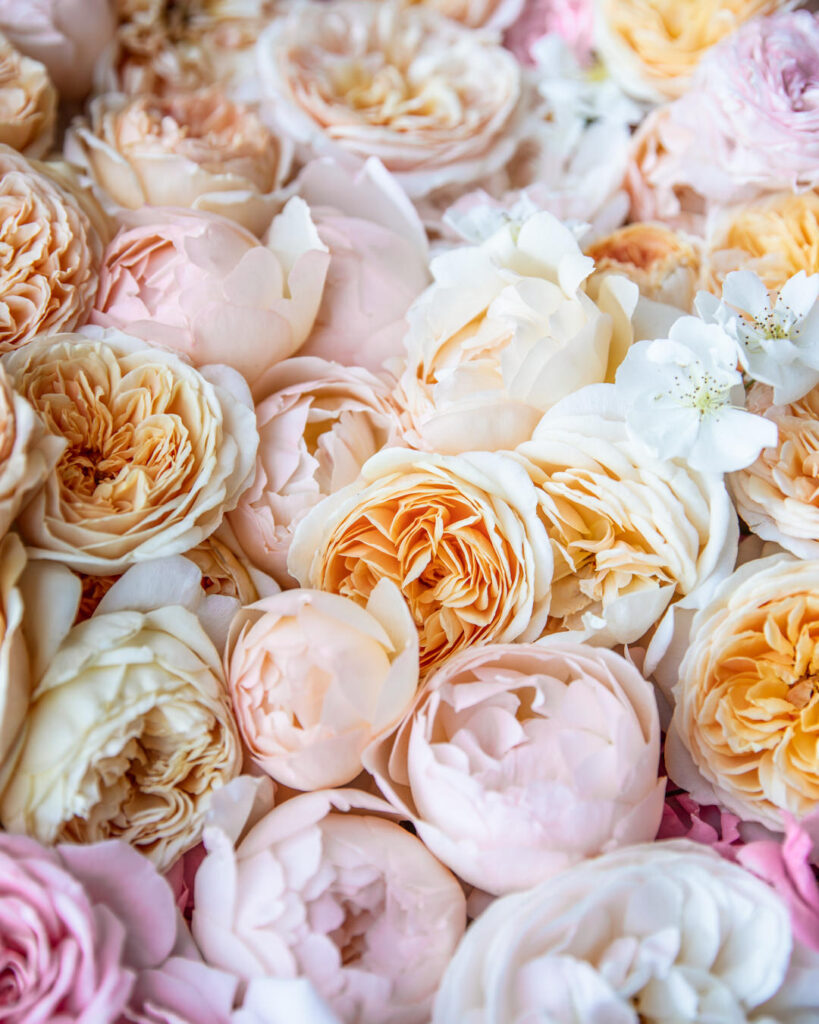
Pruning: N&B and BTS
Pruning can seem like a daunting task if you’ve never done it before, but once you get the hang of it, it is quite simple. I’ve combined these because I do it exactly like most sources recommend.
In-Season Pruning
This simply refers to deadheading, or removing spent blooms. While you don’t need to deadhead your roses, doing so does result in more blooms. On a mature rose, cut back to five or greater healthy leaflets. On a new rose (less than one year), do not remove more than half the existing plant height. It’s fine to deadhead just above the first leaflet (Alvarez).
Shape Pruning
This is not a requirement, but during the season, you may choose to prune your rose to whatever shape you want them to be. While there are no hard rules, don’t cut more than half of the height or volume of the plant.
Fall Pruning
In the fall, it’s a good idea to prune tall roses as a way to reduce their height in order to prevent cane breakage. Not all roses will need this, but a good final height is between your waste and shoulders (Alvarez).
Dormant Pruning
I actually think this is fun! Prune roses during their dormant season, which will depend on your location. You want to do your dormant pruning before the buds start to swell and push open for the season. On our farm, we dormant prune our high tunnel roses in March and outside roses in April (weather dependent).
I like Heirloom Rose’s acronym for the process: PRUNE. I also suggest checking out their post and videos here. But here is there acronym of the process:
P – PREPARE THE PLANT
Cut the plant back to about waist height so you can work safely. Side note: Alvarez notes that as a guideline, leave landscape roses at three-feet tall and field grown roses for cut flower production at 12–18-inches tall.
R – REMOVE ALL BROKEN, DEAD, DYING, OR DISEASED WOOD
Branches that look dry, shriveled or black should be removed at any time as they will no longer produce new growth. The healthy canes will be brown or green and firm. Remove canes that are crossing or rubbing, as they will create weak spots. Prune out all branches smaller than a pencil in diameter. In spring, prune out all but the healthiest/strongest 6–8 canes (floribundas and shrub roses may have more).
U – UNDERSTAND THE PLANT
Know what type of rose bush you are pruning, and how you want the bush to look as it grows out. Shape the plant with this future growth in mind.
Make final cuts at a 45-degree angle and about ¼ inch above outward-facing bud eyes (you want them to be outward facing so that new branches grow outward).
N – NOTHING LEFT BEHIND
Clean up all cuttings, dead leaves, and other debris from around the plant. Do not compost as it could spread pathogens. Leaving the area as clean as possible will minimize the growth of diseases.
E – ENJOY YOUR ROSES
That’s it! Enjoy your hard work! If you want to enjoy some cut roses, cut the stem right above the first five-leaflet leaf under the flower and immediately place the cut stem into a clean bucket of lukewarm water.
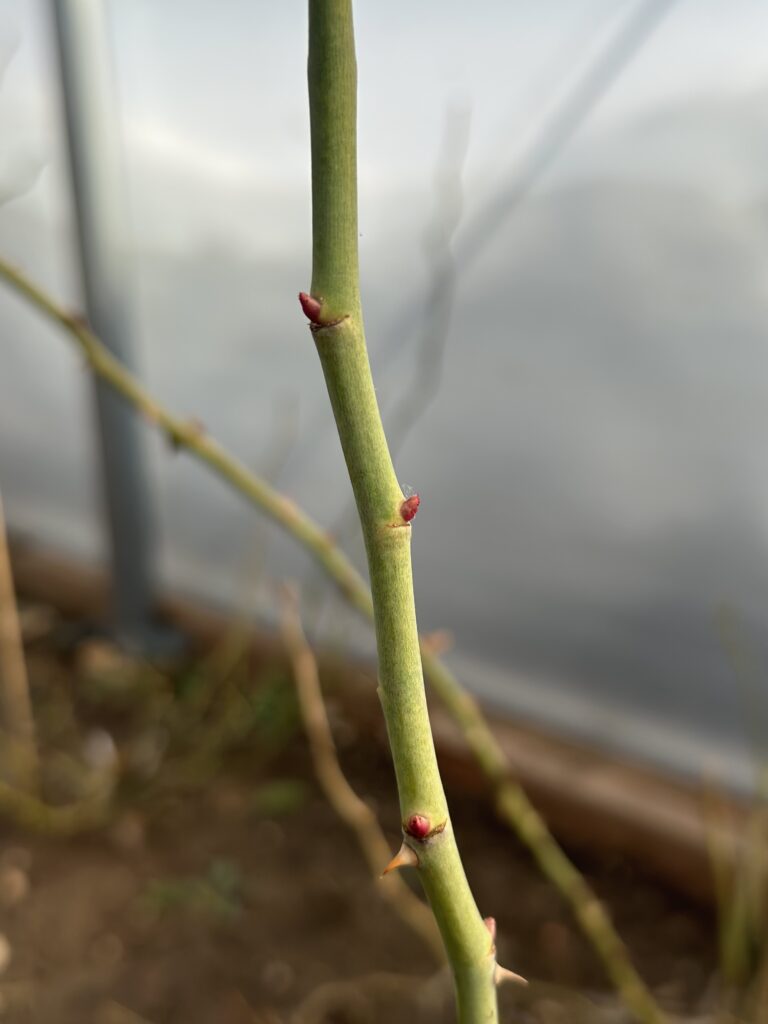
Overwintering: N&B
Whether or not roses need winter protection depends on your growing zone. Heirloom Roses suggests for Zone 7–13, mulch roses 2–3 inches thick with compost or other mulch (mild zones may not need any winter protection). For Zones 1–6, they recommend hilling up soil least 12” wide and high and then covering with compost or mulch (Alvarez suggests either compost or soil and avoiding native soil). There are also various rose cones and burrito methods, but they are all similar in theory: wrapping the rose in a thick protective layer of mulch.
Overwintering: BTS
Thus far, I have not done anything for my roses except some extra compost mulch. I haven’t had any issue yet (including Zone 5 roses), but I’ve added Zone 6 roses this season, and I plan to add a thicker layer of compost/mulch this winter. For those Zone 6 roses, I may look into some rose cones, but I have not done so yet.
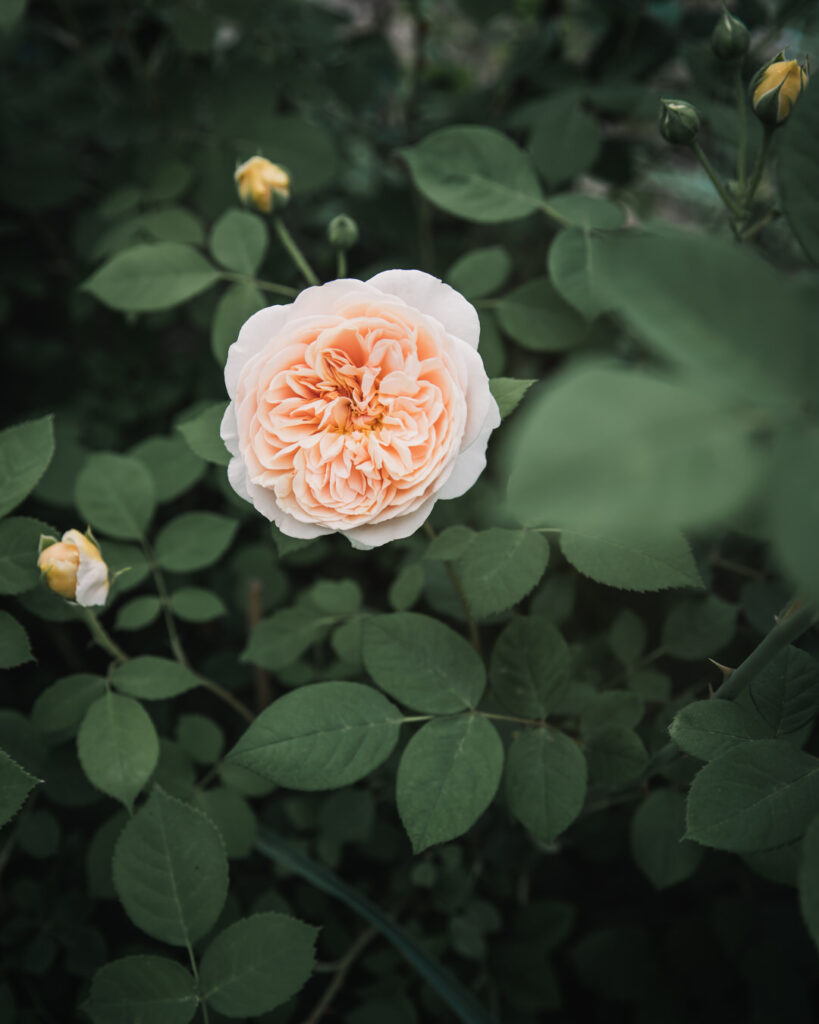
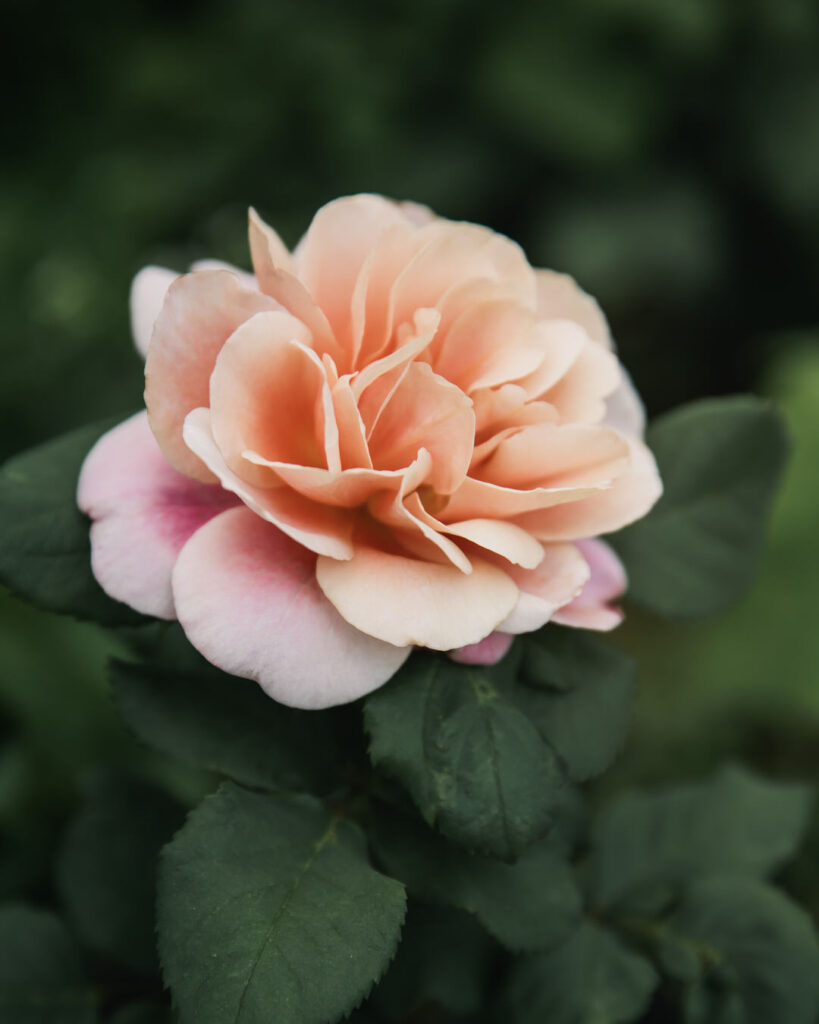
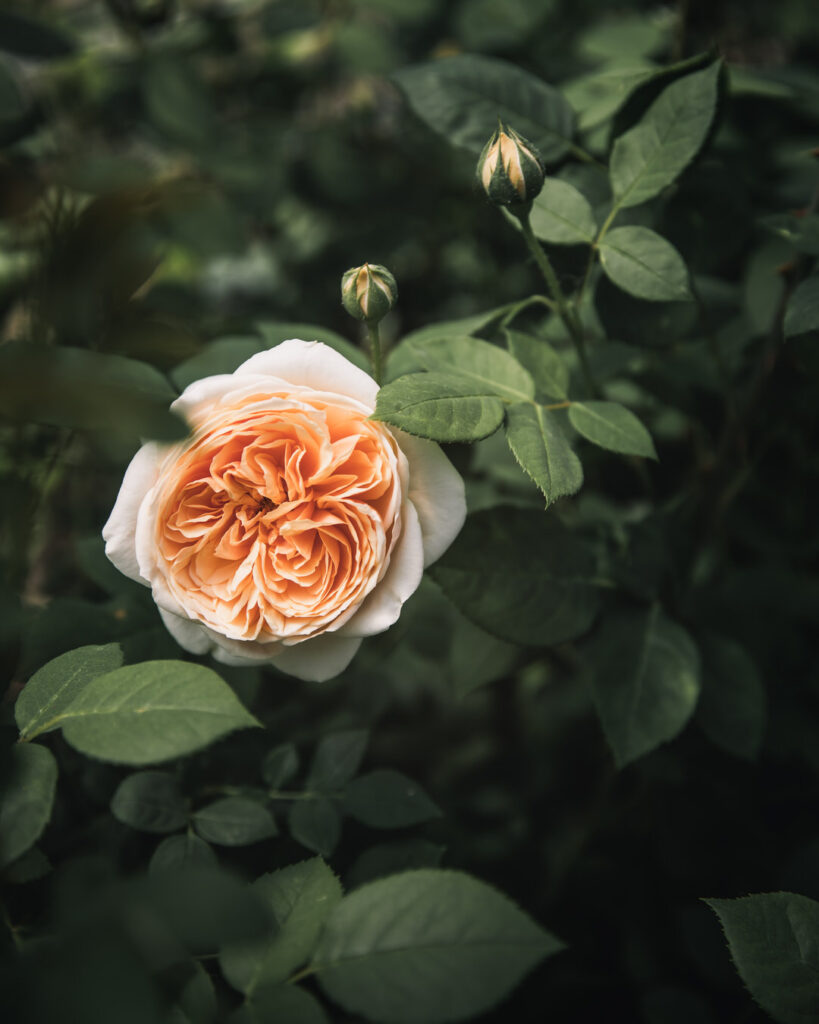
Harvest & Post-Harvest Treatment and Storage: N&B
There is not a lot of information about harvesting garden roses for cut flowers, but most of what I have learned has come from Alvarez, Erin Benzakein, and the recommendations for roses are not much different from common harvest techniques for most flowers. The difference is that some rose varieties are better for cutting than others. Some good clues are on the sellers websites, if varieties are listed for cutting, and also seeing what varieties garden cut-rose growers are growing!
While Alvarez notes that roses can be dry harvested and laid flat in the cooler for an hour or two, they ultimately should end up in clean buckets with water, and both Alvarez and Benzakein recommend using hydrators (like Chrysal Hydrating Solution or Quick Dip or both). The sooner the better.
Harvest during the coolest parts of the day and not when temperatures raise above 80F/27C (Alvarez). Benzakein recommends harvesting when one-third to one-half of flower is open, while Alvarez recommends 3/4ths of the sepals are reflexed, tight bud to marshmallow stage. It’s important to harvest before the bloom is pollinated by pollinators, as this will reduce vase life. Harvest only to the length you need, but the standard length of a commercial garden rose is 12 inches. Remove any foliage that will fall below the water line. Only remove thorns when necessary (e.g., bridal bouquet). Chill roses at 34–38F (1–3C) for at least 4 hours. Roses can be stored up to 7 days, depending on variety (Alvarez, noting that hybrid teas last the longest).
Harvest & Post-Harvest Treatment and Storage: BTS
I harvest exactly as indicated above into a bucket with Chrysal Hydrating Solution (I also have Quick Dip). I have not stored for 7 days, but I will pick all week up until an event.
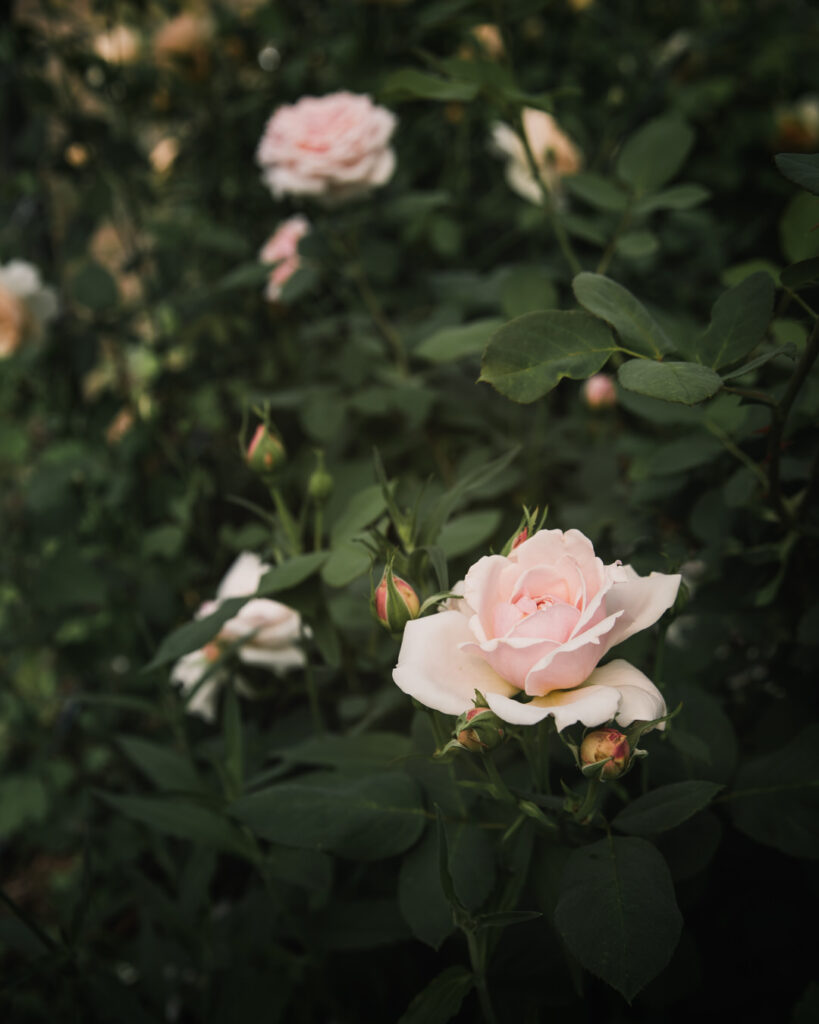
Variety Selection & When to Order: N&B & BTS
Our current roses come from Heirloom Roses (winter time) and Menagerie Farm (Alvarez’s farm, sale usually in January). Both have been excellent quality and I highly recommend both! I have also placed an order with Grace Rose Farm for next spring. They’re currently taking preorders and have a special going on where if you buy 3 roses, one is free (use code GRACIE). They also recently had 20% off, so I’m not sure if more discounts will be available soon. Of course, you can also buy directly from David Austin (heaven know I probably will this winter). If you are able to order wholesale, I believe The Little Farmhouse Flowers will be selling bareroot roses at wholesale prices soon (if not already).
In our high tunnel, we are currently growing:
- Abraham Darby
- Crown Princess Margareta
- Distant Drums
- Earth Angel
- Honey Dijon
- James Galway
- Koko Loko
- Lady Of Shalott
- Lichfield Angel
- Moonlight Romantica
- Princesse Charlene de Monaco
- Teasing Georgia
- Wollerton Old Hall
- Queen of Sweden
- Quietness
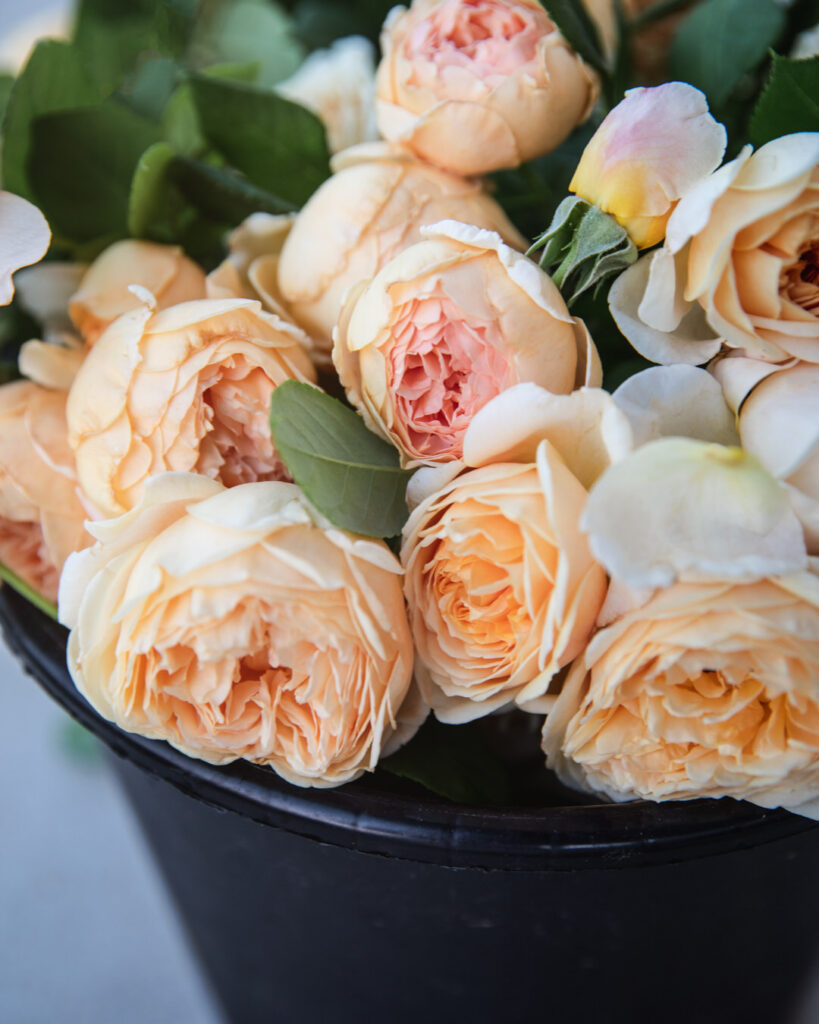
Pricing: N&B
Mayesh wholesale garden roses are around $3–5 / stem (2023) depending on variety (their deepest discount is $2.85 per stem at 504 roses as part of their David Austin wedding special, likely does not include shipping). Retail, Grace Rose Farm sells a 12-stem bunch for $99 but often have deals. GRF wholesales their roses at about $35–39 / 12st bu. That comes out to about $2.92–$3.25 / stem, BUT that price does not include shipping and they have a minimum order amount of $110. With shipping on a recent order (2024), I was paying $4.19 / stem (all in). All photos here are our own roses, but we’ve ordered GRF DA Roses for special events, like in winter, and they are chef’s kiss gorgeous.
P.S., check out the comment section for a great question on pricing plus more info.
Pricing: BTS
I don’t sell our roses by the bunch, so as of right now, they are just part of the built-in cost of weddings, events, and arrangements.
Design: BTS Only
Garden roses are so beautiful, they basically design themselves. A few tucked into an arrangement or bridal bouquet can definitely make a real wow. I do usually strip them so that they are easier to place. If the stems are weaker, I’ll use a supporting flower to kind of prop them up. If I’m using a compote, I’ll use a floral frog and/or chicken wire. Other than that, I find roses are quite delightful and easy to work with.
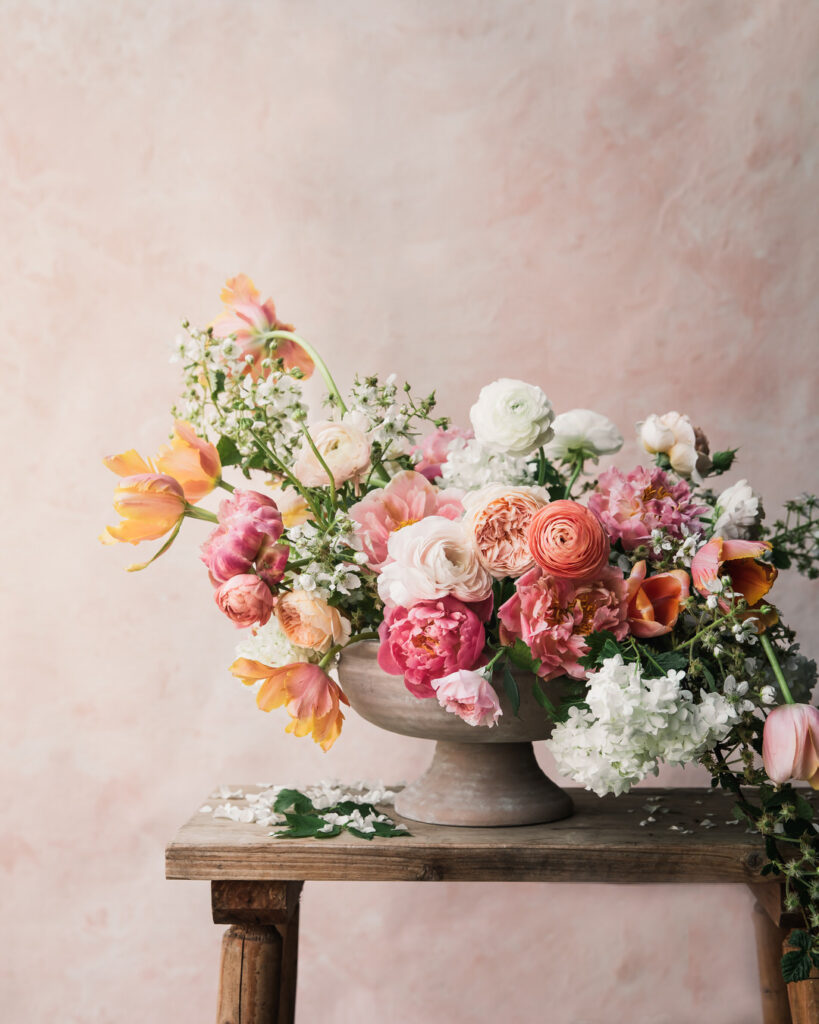
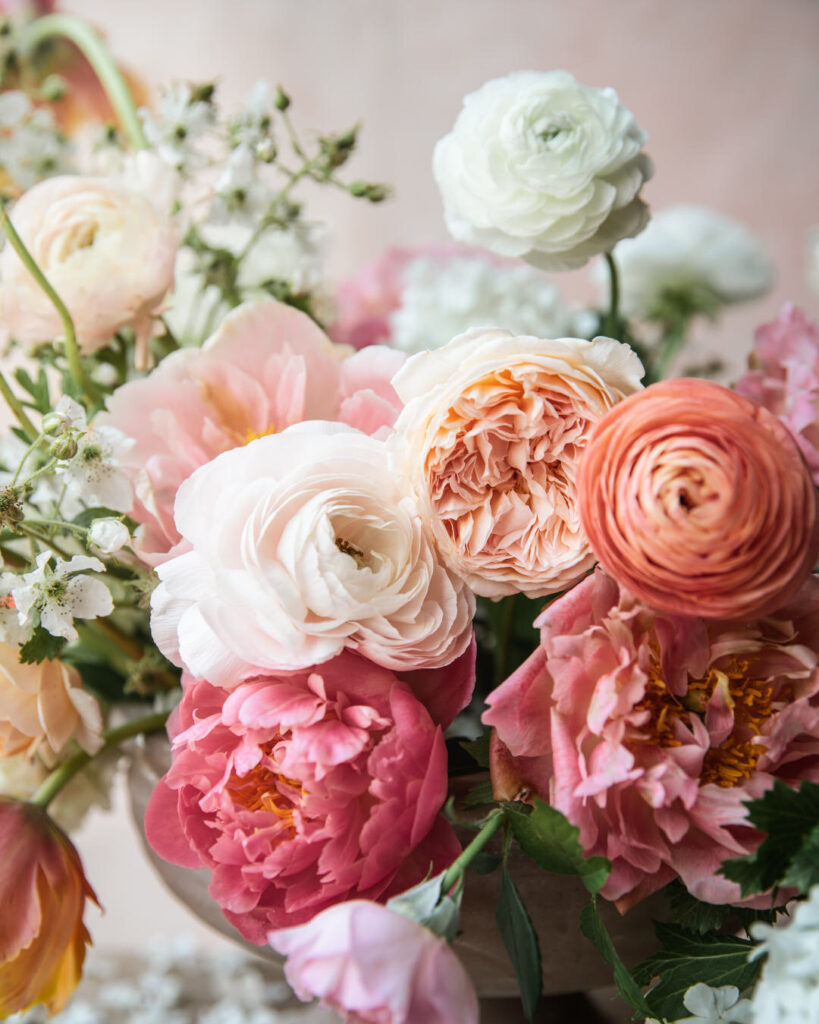
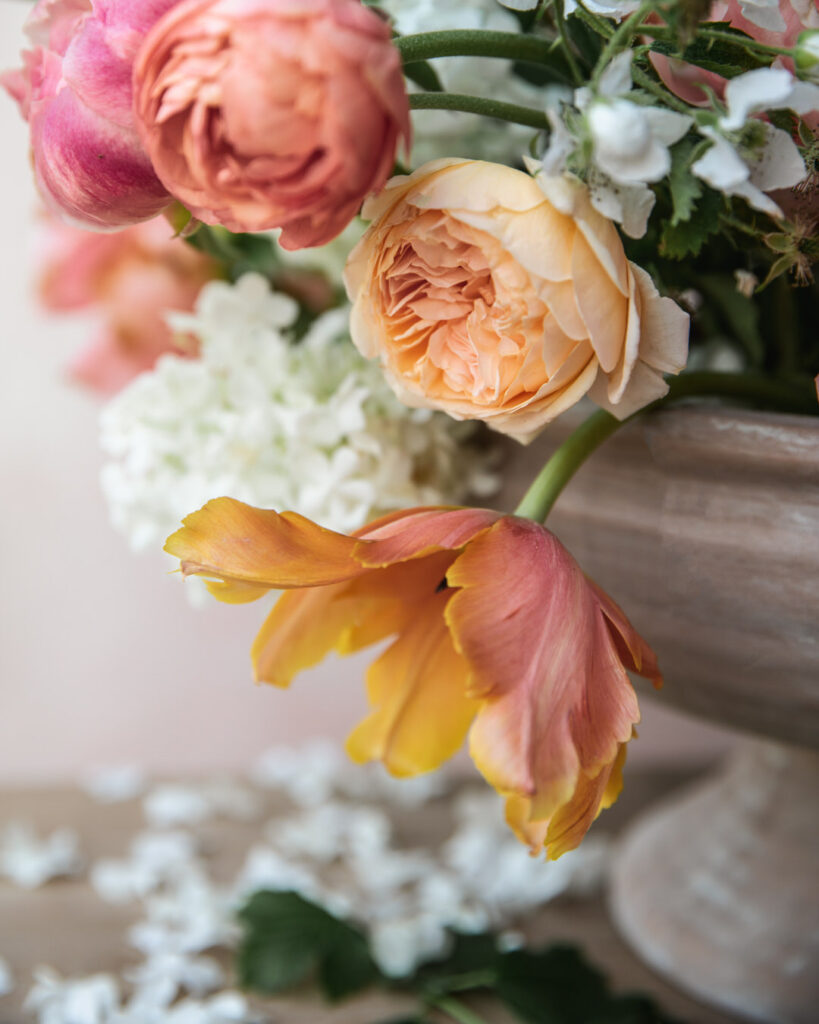
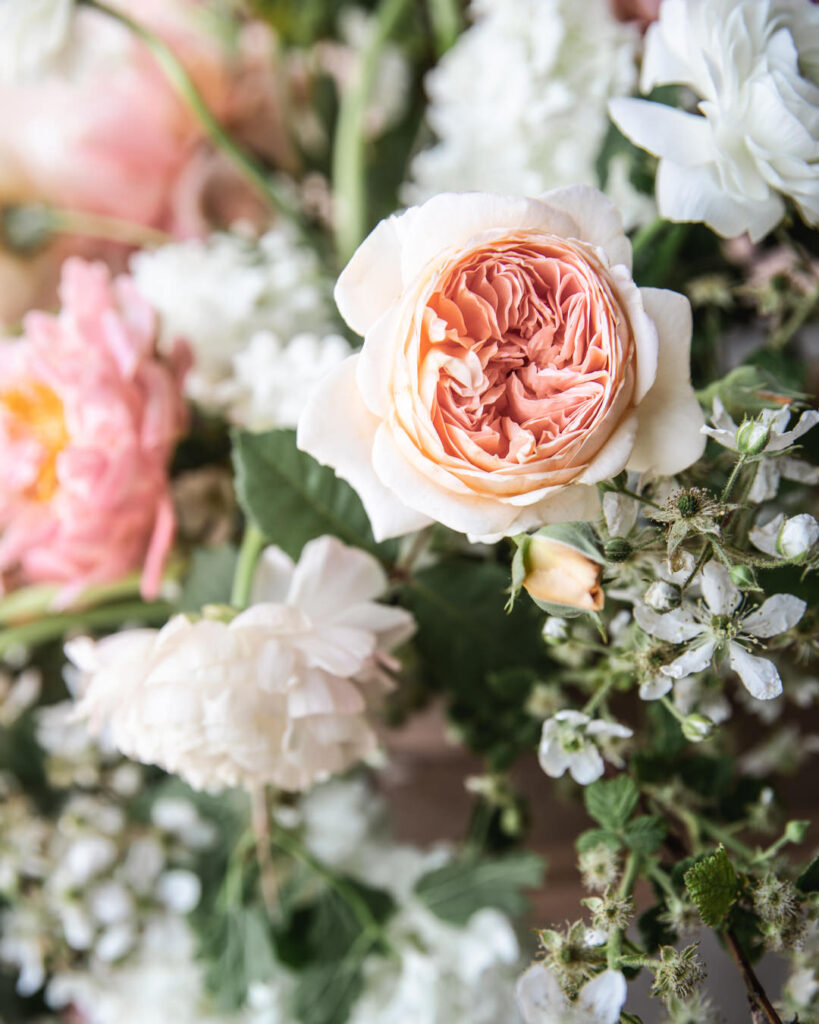
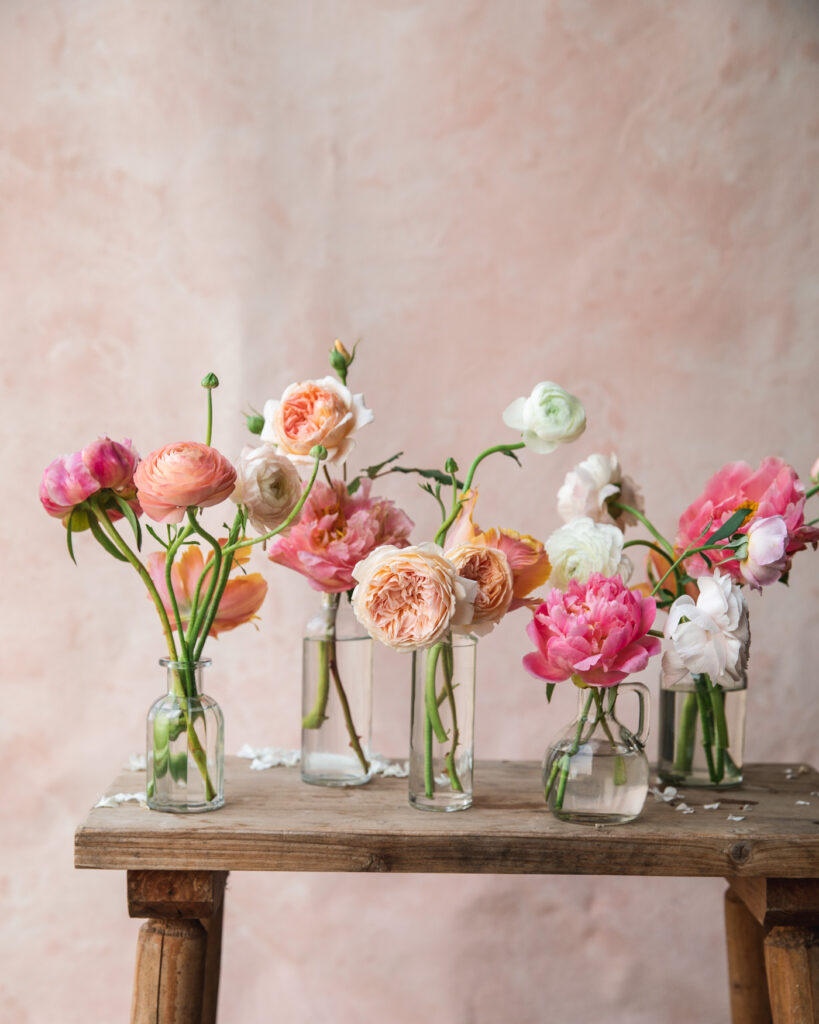
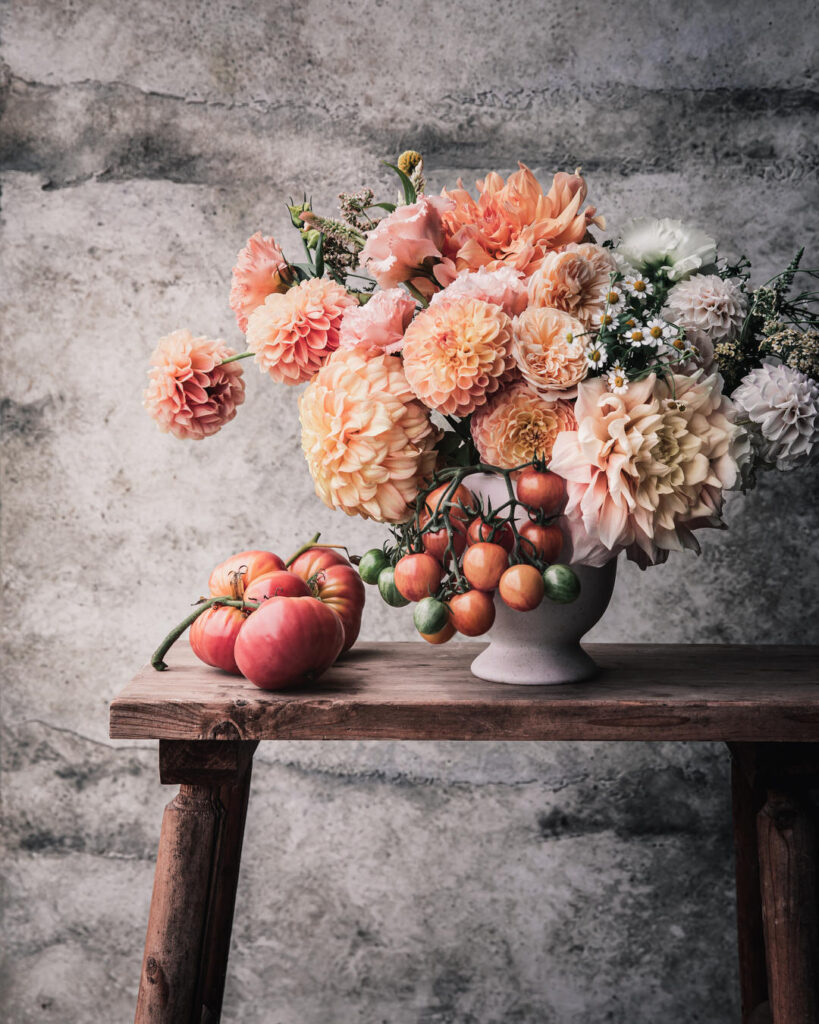
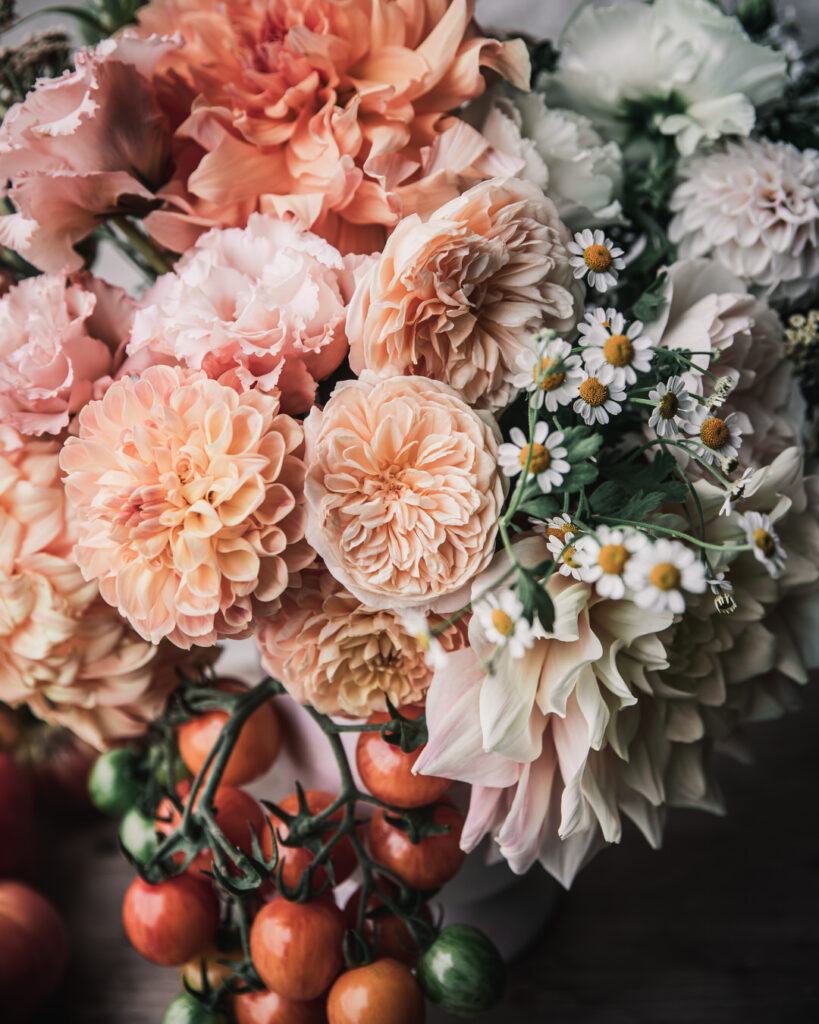
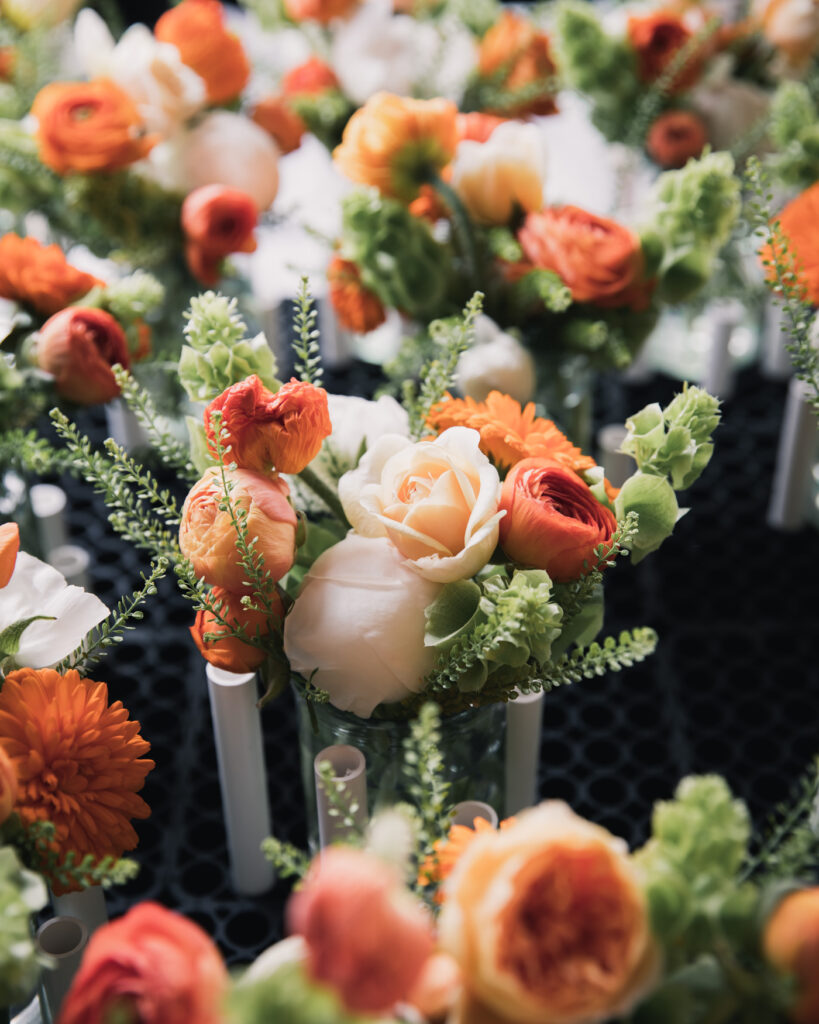
Wrap Up
OK, my friend, that is IT for July’s Plant Profile. What do you think? Did you find some useful nuggets? Is there anything that’s unclear or you wish I would have covered? Or is your head spinning? No worries, you will get a PDF copy emailed to you, so you can always refer back it. Tip: use the find shortcut (Ctrl+F on a PC or Command+F on a Mac to search for any word or term).
Have any questions or something you want to share with me or others? I know I say this ad nauseam, but I truly believe in the power of the collective and that we all have something unique and powerful to share, so please leave a question or share a comment below. We’re all better for it, and I thank you in advance!
Cheers pal!
I’m planning to start selling roses next year, I have a bunch I have purchased from GRF, florist varieties. I you mentioned for pricing roses, yours get worked in to your weddings/events, but is there a price point you would recommend? I was thinking between $4-5/stem, to florists but not sure! Ty!
Hi, Shannon:
Congrats on your roses!!! So exciting 🙂 My first recommendation will be the standard, boring answer (technically true and 100% the way to do it, but it frustrated me in the beginning bc I was like what does this even meaaaannn???), the second will be how I personally consider things, right or wrong.
When pricing a product or service, you want to consider the cost to you (cost of goods sold, labor costs, break-even point, etc.), profit margin, market, and pricing strategy. In other words, your selling price = cost + profit (i.e., what you want to make). All of this is 100% true, especially if you want a healthy, profitable business. But when you’re just starting out, it’s a little hard to conceptualize (at least it was for me).
So, right or wrong, what I like to do is look at a real-world example and then ask myself questions like: OK, assuming this is a realistic price that’s actually working for this business, is it realistic for me? Do I have the market for this and would they pay less/more for a similar-quality product? Could I get my costs down to a point where this price point would be profitable for me? Could I produce a similar-quality product? If not, could I charge less but still have it make sense? OR: could I produce a better product and ask for a better price? Is there something I can bring to the table to justify a higher price point (e.g., no chemicals, delivery included, great communication, etc.)? Would I need to implement pricing strategies to make it work (minimum order, deliveries only on certain days, etc.)? I don’t always know the answers, but that’s a little more how my thought process goes in real life. And I want to stress again, not knowing the answer does not mean I don’t try it! It’s just a thought exercise to help me have more clarity and confidence in the price! You don’t need all the answers to try and I wouldn’t spend so much time on it that I never do it (no paralysis by analysis).
So, if you’ll indulge me, let’s look at a few real-life examples! GRF wholesales their own roses at about $35–39 / 12st bu. That comes out to about $2.92–$3.25 / stem, BUT that price does not include shipping (cost) and they have a minimum order amount of $110 (i.e., part of their pricing strategy). With shipping on a recent order, I was paying $4.19 / stem (all in). Also, I do want to call out that these were *premium* garden roses. They were chef’s kiss, perfect. While I don’t know their costs, profit margins, etc., this pricing is what works for them, presumably. They also have strategies in place (like minimum orders I’m sure among many other things) that make it work for them, again presumably. And that’s an important part to call out when using real-life examples. We don’t know what’s really going on behind the scenes.
As another example, Mayesh and David Austin have recently been doing a Wedding Special Wholesale Price: $2.85 per stem. Minimum Order: 504 roses for one event. That’s a great price on DA wedding roses, but that’s also quite the minimum (at least to a small grower like me). For me, as a small grower, I would be at a higher price but lower minimums (bc I couldn’t hit that high of a minimum anyway, market vs demand). I hope this provides some good insight (I find these scenarios more helpful, ha!).
Your thoughts on pricing sound in alignment with real-life examples on the market, especially given the minimum quantities. Now it’s time to consider all of the variables.
These will be unique to you, but one thing I would suggest, if you have a relationship with your potential florists, is asking them. While only you can determine the price that makes sense for your business, understanding their typical client/budget can be helpful in determining if it’s a viable option. When I think of my own wedding clients, budget is a *major* consideration. (I actually think flower farmers have a unique edge here, but that’s for another day or this comment will get way too long). But florists are absolutely considering the couple’s budget when ordering flowers. The industry standard for wedding florists is 3x–4x the cost. A talented florist can design a beautiful budget-friendly wedding, but it’s likely not going to be filled with David Austin wedding roses. When you consider the Mayesh/DA deal (a steal of a deal on garden roses), that’s $1436.40 in rose cost ALONE. But if they have high-end clients with big wedding budgets, this absolutely makes sense! High-end florists want high-end flowers and it’s fun to geek out on flowers regardless of style. The ability to have this conversation will depend on each florist and your relationship, but I do this all the time 🙂 I just tell them I am new to selling x type of flower and want to make sure our price works for our business, but also for them and the quality they are expecting. Florists are some of my favorite people ever, and they are usually really great partners in understanding the business and market. Whenever a new florist reaches out, I always ask them what flowers they love, what they cannot get enough of, what colors they are into and what they have a hard time sourcing. Surprisingly, I’ve found that most have their own personal preferences and then say, but my clients are constantly asking for XYZ (the point being they have a really good idea of what your local market is asking for).
OK, those are my thoughts on the subject, I hope that helps but let me know if I can clarify anything. It’s an awesome question, so thank you 🙂
Thank you so much that’s super helpful!! I think it will be hard for me to grow roses that would be exactly like the ones florists can get from the wholesaler since mine are field grown and I grow organically, although I will say the stems in the O’hara plants I planted out in the spring were massive and one of my florists commented how great they looked! But I do think being able to offer smaller quantities, like if they just needed some stems for a bridal bouquet for example, would keep my pricing competitive. Anyways this gives me a lot to think about, the rose bushes are a large investment compared to other flowers I grow so pricing them and selling them I think will be a bit more tricky than usual annuals I grow! Thanks so much again for your helpful advice!!